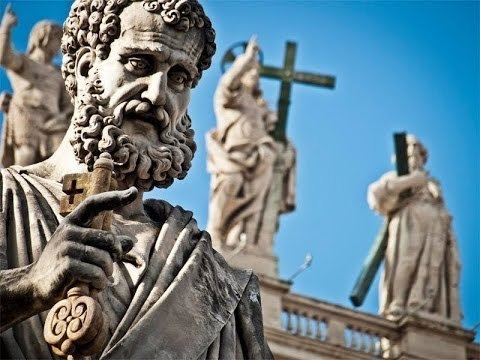 | ||
Vicar of Christ (from Latin Vicarius Christi) is the term used in different ways, with different theological connotations throughout history. As the original notion a vicar is of "earthly representative of God or Christ" but also used in sense of "person acting as parish priest in place of a real person" The title is now used in Catholicism to refer to the bishops and more specifically to the Bishop of Rome (the pope).
Contents
History and different uses
During the history of Christianity, the title of Vicar of Christ was used in different ways, with implications for theological, pastoral or different time.
Use for the bishops
The first record of the concept of the Vicar of Christ is mentioned in the Epistle to the Magnesians of St. Ignatius, Bishop of Antioch, who was possibly a disciple of both John the Apostle and Saint Peter, with a pastoral sense, written between the years 88 and 107 AD "your bishop presides in the place of God (...)". Although Ignatius did not explicitly use the term Vicar of Christ, he clearly sets out the concept. More recently, the Second Vatican Council's Dogmatic Constitution on the Church Lumen gentium noted that bishops are "vicars and ambassadors of Christ," and the Catechism of the Catholic Church notes that each bishop governs his diocese "[a]s Christ's vicar."
The second recorded use of the term "Vicar of Christ" is found in the epistles of Tertullian in the 3rd century, with a different theological slant to refer to the Holy Spirit, that is, as Christ is not physically performing miracles in the Church, Holy Spirit acts as his Vicar on his behalf, performing miracles and preventing the Church err. It is unknown whether this term was widely used in the early Church, or whether it was a personal theological observation of Tertullian.
Use for the Popes
The third use of the term Vicar of Christ appears in the 5th century, in a synod of bishops to refer to Pope Gelasius I. The theological connotations of the title got a pastoral sense, evoking the words of Christ to the Apostle Peter, regarded by the first Catholic Pope in John 21:16-17, "Feed my lambs... Feed my sheep", so Christ made Peter his vicar and pastor with the responsibility to feed his flock (i.e. the Church) in his own place.
However, the use of the title to refer to the popes in the early Church was unstable, and several variants of the use of Vicar were used for the Pope, as "Vicar of Peter", indicating that they were the successors of St. Peter, "Vicar of the Prince of the Apostles" or "Vicar of the Apostolic See", among other variants. This title is used by the Roman Missal in their prayers for a dead pope, and the oath of allegiance to St. Boniface to Pope Gregory II. Since 1200, Popes have consistently used this title. Insisting that he - and he alone - had the right to remove bishops from office, Pope Innocent III appealed to the title of Vicar of Christ. (cap. "Inter corporalia", 2, "De trans. ep.") Occasionally, Popes like Nicholas III used "Vicar of God" as an equivalent title) The 2012 edition of the Annuario Pontificio gives "Vicar of Jesus Christ" as the second official title of the Pope (the first being "Bishop of Rome").
Use in Caesaropapism
Another use of the title, with a different meaning, appeared in the Eastern Churches, in use between the century fifth and sixth, the term was used to refer to the Byzantine emperor, showing the apex of caesaropapism. Though decisions on doctrine, liturgy and spirituality were left to the bishops, (notably in Church Councils, where the Emperor often played a key role, already since the time of Constantine the Great) the Emperor constantly had tremendous influence on the church, which was increasingly charged with tasks in the service of the crown, such as supervising temporal authorities.
